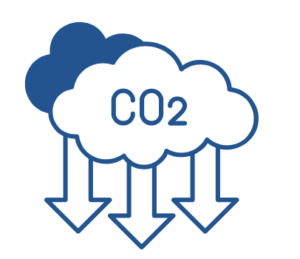Carbon Accounting is still relatively new and with it comes many new terms for a lot of us. We’re here to help you understand some of the most used ones in the world today.
Terms Related to Understanding Carbon Emissions

Greenhouse gases (GHGs): A group of gases that trap heat in the Earth’s atmosphere, causing global warming and climate change. The main greenhouse gases are carbon dioxide (CO2), methane (CH4), nitrous oxide (N2O), and fluorinated gases, commonly used as refrigerants.
GHG Protocol: The globally recognized set of standardized guidelines and protocols for quantifying and reporting greenhouse gas (GHG) emissions. CarbonSuite is built in alignment with the GHG Protocol.
Emission Source: A specific entity, process, or activity that releases greenhouse gas emissions into the atmosphere. Example: A coal-fired power plant. It releases carbon dioxide and other gases when burning coal to generate electricity.
Carbon Dioxide Equivalent: Carbon dioxide equivalent (CO2e) is a unit of measurement that expresses the global warming potential of various greenhouse gases. It is measured in terms of the amount of carbon dioxide that would have the same impact over a specified period. Example: If a ton of methane has a global warming potential 25 times that of carbon dioxide over a 100-year period, it would be measured as 25 metric tons of CO2e.
Terms Related to Categorizing Emissions

Emission Category: A specific group or classification of greenhouse gas emissions based on their source or activity, as defined by the GHG Protocol. Examples: Stationary Combustion, Mobile Combustion, Purchased Energy, Business Travel, Employee Commuting, Waste Generated in Operations.
Scope 1 Emissions: Direct greenhouse gas emissions from sources that are owned or controlled by an organization. This pertains to emissions from on-site fuel combustion or industrial processes. Examples: vehicles, furnaces, natural gas bills, cement manufacture.
Scope 2 Emissions: Indirect greenhouse gas emissions resulting from the generation of purchased electricity, heat, or steam consumed by an organization. Example: electricity utility bills.
Scope 3 Emissions: Indirect greenhouse gas emissions that occur throughout an organization’s value chain. This includes both upstream and downstream activities. This includes transportation, waste generation, and product use. Examples: purchased items, employee travel, waste management.
Terms Specific to Carbon Accounting

Organizational Boundary: The physical or operational limits within which an organization accounts for its greenhouse gas emissions. Example: An organization may set its organizational boundary to include all emissions from its owned and controlled facilities, but exclude emissions from suppliers and contractors.
Emission Factor: An emission factor is a coefficient or conversion factor that relates the amount of greenhouse gas emissions produced to a specific unit of activity or output. Example: An emission factor for gasoline combustion would express the amount of carbon dioxide released per gallon of gasoline burned.
Carbon Ledger: The backbone ledger of CarbonSuite. Each Emission and Offset transaction will be posted to the Carbon Ledger, which records the activity amount and the emissions amount in greenhouse gas and in Carbon Dioxide Equivalent (CO2E).
Carbon Offset: A reduction in emissions of carbon dioxide or other greenhouse gases made in order to compensate for emissions made elsewhere. You can purchase offsets to help lower your the carbon footprint of your business.
Terms Related to Sustainability Reporting and Requirements

CDP: (Carbon Disclosure Project). A non-profit organization that runs a global disclosure system for companies and cities to report on their environmental impacts. It focuses specifically on their greenhouse gas emissions and climate change strategies.
ESG reporting: The process of measuring, disclosing and being accountable for an organization’s environmental, social and governance impacts. Find out what requirements your business may be subject to on our Climate Disclosure Tracker.
CSRD: (Corporate Sustainability Reporting Directive). EU law requires all large companies and all listed companies (except listed micro-enterprises) to disclose information on their risks and opportunities arising from social and environmental issues, as well as the impacts of their activities on people and the environment. This helps investors, consumers and other stakeholders to evaluate the sustainability performance of companies. It was implemented as part of the European green deal.
SEC Climate Mandate: The SEC has issued interpretive guidance to companies on how to disclose the financial risks associated with climate change. This includes the impact of climate change on their operations and financial condition.
TCFD: (Task Force on Climate-related Financial Disclosures) is an organization established by the Financial Stability Oversight Council, which is a group of central banks and regulators, to develop recommendations for how companies should disclose information about the financial risks they face from climate change.
GRI: (Global Reporting Initiative) is a non-profit organization that provides a framework for sustainability reporting.
ISSB: (International Sustainability and Social Impact Standards Board) is an independent organization that is working on developing global sustainability standards.
SBTI: (Science Based Targets Initiative) is a partnership between CDP, the United Nations Global Compact, World Resources Institute (WRI), and the World Wildlife Fund (WWF) that helps companies set science-based targets to reduce their greenhouse gas emissions.
Terms Related to Emission Reduction

Life Cycle Assessment (LCA): A methodology for evaluating the environmental impacts of a product or service throughout its entire life cycle, from raw material extraction to disposal.
Materiality: The significance of an item to the financial statements and sustainability reporting of a company, organization, or government. It determines what information to disclose in financial statements. It also determines how to disclose this information.
Net Zero: A balance between the amount of greenhouse gases emitted and the amount removed from the atmosphere. The result is in no net increase in atmospheric greenhouse gas levels.
We hope our glossary has helped you better understand the Carbon Accounting terms commonly used today. Learn more about Carbon Accounting with our Carbon Accounting 101, or send us an email!

